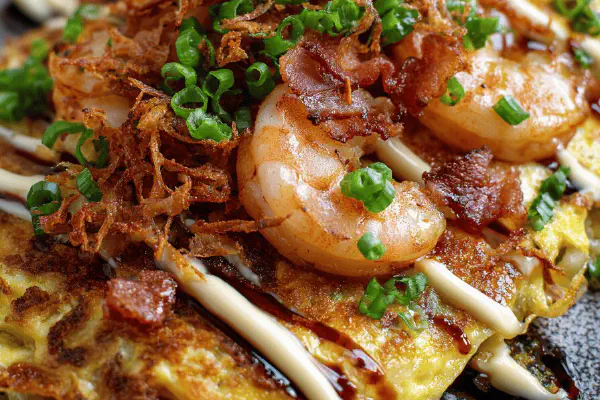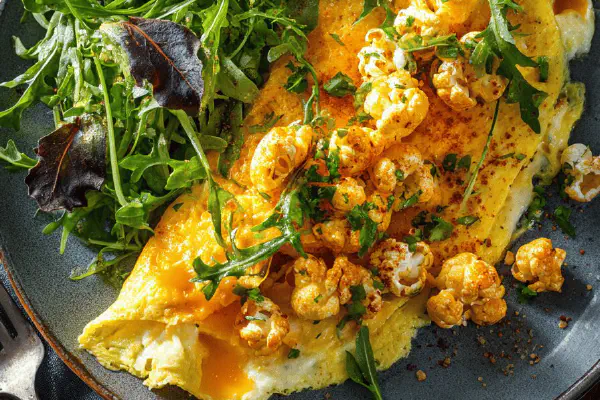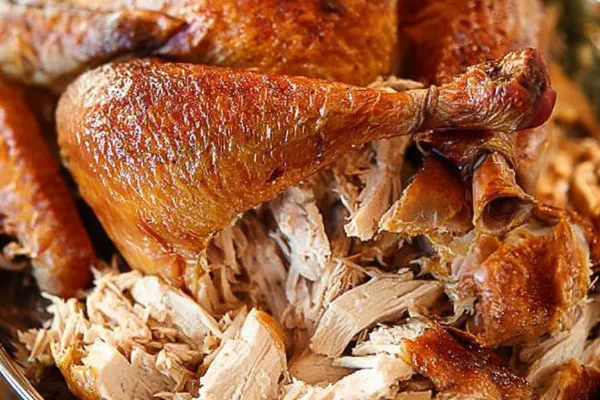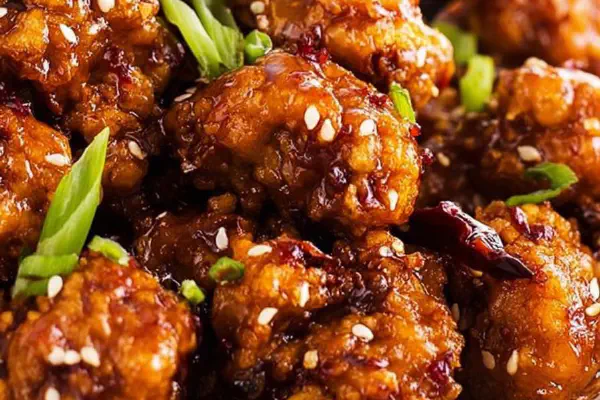Seafood Cabbage Omelette

E
By Emma
Certified Culinary Professional
•
Recipe tested & approved
An okonomiyaki twist using eggs, napa cabbage, smoky pancetta instead of lard, and shrimp. Slightly different spice and texture play with the addition of sesame oil and tamari replacing soy sauce. Garnished with crispy fried shallots and a drizzle of spicy mayo and tonkatsu sauce. Cook times adjusted for slightly longer cabbage sauté and omelette browning.
Prep:
20 min
Cook:
15 min
Total:
35 min
Servings:
2 servings or 4 starters
#Japanese cuisine
#seafood recipe
#omelette
Eggs, cabbage, shrimp. Pancetta swaps in for smoky bacon. Flour binds. Tamari replaces soy. Sesame oil adds nuttiness. Onion and green onion chopped fine. Simmer ingredients till softened, shrimp blush pink. Combine with egg batter. Skillet hot. Oil slick. Pour batter wide, thin. Cook long enough for crust to form. Flip carefully. Warm through till just done. Cut. Drizzle spicy mayo, tonkatsu sauce, sprinkle crispy shallots and aonori powder. Bonito flakes flutter. Steamy, savory bites. Slightly sweet, smoky, tangy. Fusion vibes. A take on Japanese street food with a touch of Italy in pancetta.“
Ingredients
- 3 large eggs
- 60 ml (4 tbsp) unbleached all-purpose flour
- 5 ml (1 tsp) tamari
- 1 small green onion, thinly sliced
- 300 ml (1 1/4 cup) finely shredded napa cabbage
- 1/2 small yellow onion, finely diced
- 65 g (2 1/4 oz) smoky pancetta, diced
- 20 ml (1 1/3 tbsp) canola oil
- 7 medium raw shrimp, peeled and cut into 1.5 cm (2/3 inch) pieces
- 3 ml (1/2 tsp) toasted sesame oil
- 1/2 tsp powdered dried seaweed or finely shredded nori
- Japanese spicy mayonnaise to taste
- Tonkatsu sauce to taste
- 2 tbsp crispy fried shallots
- Bonito flakes to taste
About the ingredients
Eggs large and fresh make a fluffier base. Use unbleached flour for better texture. Napa cabbage is preferred for sweetness and softness but you can use green cabbage if necessary; just cook a little longer so it softens uniformly. Tamari is a gluten-free soy sauce alternative that brings depth without too much salt. The smoky pancetta adds fat and flavor, substituting original bacon or lardons. Sesame oil, added to the batter, introduces warmth and nuttiness, shifting the flavor profile slightly Asian-Italian. Green onion in batter. Yellow onion for sweetness and crunch if not fully cooked soft. Raw shrimp are peeled and chopped for bite-sized morsels. Dried seaweed powder or shredded nori for subtle umami topping. The crispy fried shallots replace bonite flakes for crunch, though bonito imparts smoky seafood notes. Japanese spicy mayo gives zing versus plain mayo. Tonkatsu sauce for sweet tang and umami balance.
Method
- Whisk eggs, flour, tamari, and sesame oil in a bowl until smooth. Stir in the green onion.
- Heat half the canola oil in a nonstick skillet over medium heat. Cook cabbage, onion, and pancetta until cabbage softens and onion turns translucent, around 7 minutes. Add shrimp and cook 2 minutes more.
- Combine shrimp and veggie mix with egg batter, folding gently.
- Wipe skillet clean. Reheat remaining oil on medium. Pour batter mixture, spread into a flat round about 1.2 cm (1/2 inch) thick.
- Cook 3 minutes or until golden underneath. Flip carefully, cook an additional 1.5 minutes or until set through.
- Transfer to a cutting board, slice into squares or wedges.
- Plate immediately. Sprinkle seaweed powder and fried shallots on top.
- Add a squiggle of spicy mayo and tonkatsu sauce. Finish with bonito flakes that flicker on the hot surface.
Cooking tips
Whisk eggs, flour, tamari until no lumps. Add sliced green onion last to keep brightness intact. Sauté cabbage, onion, and pancetta in half the oil till transparent and soft, stirring occasionally for even color. Shrimp added last to prevent toughness, cook briefly until opaque. Mix shrimp-veggie mix into egg batter gently to avoid breaking shrimp or overworking flour. Skillet wiped clean to prevent burning, reheated with oil for even nonstick cooking. Pour batter and spread with spatula for approx 1/2 inch thickness, essential for even cooking inside without burning bottom. Cook longer on first side for deep golden crust, flip carefully using wide spatula or plate if needed, cook shorter on flip side to keep moist interior. Transfer omelette carefully, slice while hot for neat pieces. Serve immediately to preserve heat and flake movement. Garnish evenly. The bonito flakes will curl and move when hot, signaling freshness. This is a quick, vibrant meal ideal for busy nights or sharing appetizers.
Chef's notes
- 💡 Use large eggs. Fresh ones give the omelette fluffiness. Egg quality affects texture, look for bright yolks. Flour, unbleached all-purpose. Makes a difference on lightness. Right flour binds well. Exhaustive research indicates using more of it will ruin consistency. Too much will weigh down. Only what’s needed.
- 💡 Napa cabbage preferable over green cabbage. Sweetness in napa adds flavor. Tender texture. If you substitute, cook longer till soft. Examine cooking times. Even cooking is key for consistency. Onion adds sweetness too; yellow onion is best. Ensure it is finely diced for proper cooking.
- 💡 Pancetta gives a smoky twist to this dish. Cooks beautifully. Substituting bacon? Opt for a similar weight. Thickness impacts final flavor. Shrimp important for proteins. Chop smaller bits to integrate flavors with the batter. Don’t overcook shrimp. They need to remain tender and juicy, just until pink.
- 💡 Careful flipping. Flip gently, using a spatula. Avoid breaking the omelette. Can use a plate for support if needed. Browned bottom means deliciousness. Even don’t rush cooking. Follow timing for perfect golden crust. One side long, flip shorter. It’s about balance in serving heat.
- 💡 Serve hot! Presentation matters. Drizzles of spicy mayo and tonkatsu sauce. Crispy shallots for texture. Bonito flakes should move when hot. Stability in garnishing. The dish wilts quickly once plated outside. Eat immediately to enjoy flavors combined. Essential for that authentic touch.
Common questions
Can I replace tamari?
Yes, soy sauce can work but may increase saltiness. Adjust seasoning. Explore coconut aminos as gluten-free option. Differences in flavor.
How to store leftovers?
Store in an airtight container. Refrigerate up to two days. Reheat on skillet in low heat. Avoid microwave to retain texture. Freshness decreases.
What if I can't find cauliflower?
Try zucchini, finely shredded can work too. Cook it longer for moistness. Not all vegetables will replicate taste.
Can I use frozen shrimp?
Sure, but thaw first. Drain excess moisture. Freshly cooked shrimp have better taste. Consider that in quality.



